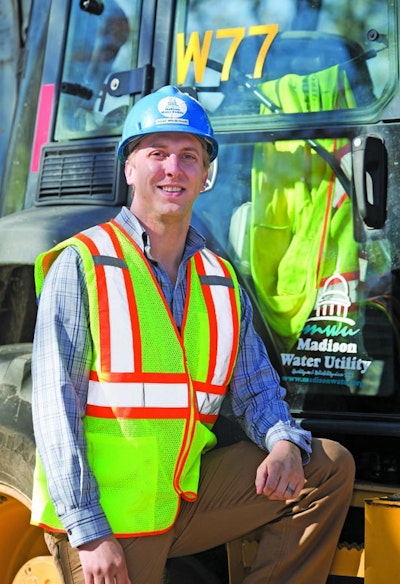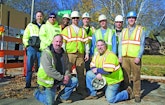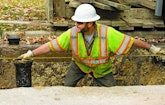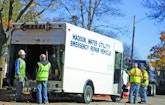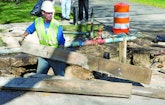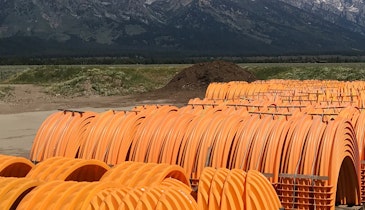
Interested in Rehab/Relining?
Get Rehab/Relining articles, news and videos right in your inbox! Sign up now.
Rehab/Relining + Get AlertsEven though the city is nearly surrounded by lakes, Madison, Wis., doesn’t take water for granted.
To protect its water supplies and infrastructure, the Madison Water Utility is fully committed to water main replacement and rehabilitation, advanced metering and online water-use tracking, wellhead protection, water conservation and a unique public outreach program that supplies cold freshwater to attendees at area events and gatherings.
And while water usage dipped to 68.5 gallons per person per day in 2013, the utility’s goal is a daily usage rate of 58 gallons per person by 2020.
“Sustainability is at the core of everything we do,” says Madison Water Utility General Manager Tom Heikkinen. “It’s our responsibility to make sure our children and grandchildren inherit a water system that is as good or better than what we have today.”
Madison’s drinking water is drawn from a deep sandstone aquifer, pumped to the surface through 22 wells. Naturally filtered, it’s of such high quality that at most wells it only requires disinfection before being pumped into the city’s 828-mile-long distribution system, which serves Madison, Shorewood Hills, Maple Bluff, portions of Fitchburg and the towns of Madison and Burke.
Small feed systems add chlorine and fluoride to the supply at each wellhead. Then, seven pumping stations move 28.3 million gallons per day of finished water to the utility’s 67,800 connections, which include residences and businesses as well as major medical facilities and the University of Wisconsin’s main campus.
The utility tests the water from each well daily.
The system includes 10 pressure zones, six elevated towers and 24 ground-level reservoirs that provide 33 million gallons of total storage capacity.
Important infrastructure
Because the water infrastructure is so important to the community’s high quality of life, Madison has embarked on the daunting task of replacing nearly half its water mains — some 400 miles of pipe — over the next 25 to 30 years. Some of the mains date to the late-1800s; many other lines were laid during the 1930s, ‘40s and ‘50s and are made of spun cast iron, a brittle material prone to breaks.
Adam Wiederhoeft, the project engineer responsible for water main rehabilitation and replacement projects, says catastrophic main breaks have been completely eliminated where water mains have been rehabilitated or replaced.
“Last year we had over 300 main breaks,” he says. “These are catastrophic events with a lot of water loss and a significant amount of expense in time, equipment and materials. But in places where we’ve replaced or rehabbed the water mains, we haven’t had a single break.”
Madison’s replacement/rehabilitation program is ramping up from 1 to 2 miles per year in the past, to 7 to 8 miles a year now. The utility plans to be working at a 10- to 12-mile-a-year pace by 2020.
It’s costly, averaging about $950,000 per mile. “We spent $7.5 million in 2013 and expect to be spending $12.7 million annually by the end of this decade,” Wiederhoeft says.
He says the utility carefully prioritizes the projects between replacement and relining.
“We’ll do full pipe replacement where major street reconstruction is scheduled,” he says. “All city departments and utilities — sewer, stormwater, gas and electric — may be involved.” The utility is open to and has used numerous installation methods — from traditional open-cut trench installation to trenchless methods such as horizontal directional drilling, jack and bore, pipe bursting and more. Cement-lined ductile iron pipe wrapped in plastic sheeting is the choice for replacement.
Rehabilitation with pipe relining occurs in areas that have experienced major pipe breaks, but total street reconstruction is not scheduled. “We isolate areas where we’ve had breaks and where street resurfacing may be scheduled,” says Wiederhoeft. “If the pipes are adequately sized for fire protection and are safely away from sewer lines, they become top contenders [for relining].
“We started using structural CIPP to reline old water mains in 2011,” Wiederhoeft says, noting that Madison was the first water utility in Wisconsin to do so. A contract awarded to Fer-Pal, using the Aqua Pipe technology developed by the Canadian firm Sanexen, served as a pilot project in that first year.
In the Aqua Pipe system, the liner is pressed and held against the inside wall of the host pipe with water pressure. The water is circulated through a heater to raise the temperature and trigger the epoxy cure.
Since that first year, however, the utility has taken on more of the supporting tasks, including excavation, water main reconnections, hydrant and valve replacement, restoration and conducting all the necessary water quality sampling and testing procedures.
“We are looking at other cities to see how they are handling more and more of the work in-house,” says Wiederhoeft. “As we ramp up the number of projects, timing and scheduling become more critical.”
Don Russell, lead worker on the relining projects, says bringing more of the ancillary work in-house keeps the utility’s staff involved in the project and saves money.
Russell says that while specialty tasks like tapping into the liner and arranging the temporary water systems are handled by the lining contractor, the Madison staff has been digging all the access pits, replacing connecting pipes to hydrants and handling the asphalt reconstruction. “It’s something we’re already familiar with,” he says, so no special training is required.
In addition to the CIPP method of relining, Madison is also exploring spray-applied structural lining systems. “The end result is about the same [as CIPP],” says Wiederhoeft. “It will enable more contractors the opportunity to participate on our relining projects.”
Whichever relining method is used, the utility saves about a third of the cost of water main replacement, Wiederhoeft estimates.
Metering and tracking
If Madison’s underground infrastructure is out of sight, out of mind, the city is trying to make water usage easy to see and top of mind.
A new automated metering (AMI) system from Itron and online water tracking feature (Harris Utilities) are designed to make citizens very much aware of their water usage and to help the community reach its ambitious water use reduction targets.
“Until just a couple of years ago, we were reading meters by going from house to house,” says Amy Barrilleaux, public information officer for the utility. “But now we’ve installed the AMI system, enabling us to read water usage remotely and bill monthly. We share that data with our customers. They can see how much water they use without having to run down to the basement, take a reading, then shower and run back down to the basement to see how much water they used. Customers don’t want to do that. Now they can view their usage down to the hour from a computer or smartphone.”
The utility conducted an extensive public outreach campaign to support the installation of the AMI system in each of 67,800 customer locations. The utility called the $14 million effort Project H2O, and it took two and a half years to complete.
“It was a giant leap,” Barrilleaux says. “We went from the most outdated system to cutting-edge technology.”
The e-billing capability has led to another innovation — the ability for customers to track their water consumption online. About one-third of Madison’s customers already use e-billing, and now they can access the tracking feature from the e-billing page and view their precise water consumption.
Barrilleaux says the utility installed the online feature at a cost of $50,000 and put it into play last October. Barrilleaux says 1,200 customers signed up for the online tracking feature in the first month.
“It’s a great conservation tool for our customers,” says Barrilleaux. The feature shows water usage history for each account and can be set up with an alert that notifies customers by email when they have reached predetermined water usage amounts.
Barrilleaux says the utility plans to publicize the feature aggressively next spring when customers begin watering lawns and gardens, activities that can push water usage to high levels.
“It’s our hope that at some point all of our customers — not just a few — will log on to see how they’re using water when they pay their bill online.”
Getting the word out
In Wisconsin, it’s not uncommon to see beer being dispensed from trailer-mounted taps. But you don’t often find fresh, cold drinking water being served up in a similar fashion.
Unless you attend one of the many summer events in Madison. There, you may well experience Madison Water Utility’s “Water Wagon,” a unique trailer designed to be hooked up to a freshwater supply such as a drinking fountain, enabling kids and adults to fill up their reusable water bottles with some of Madison’s finest.
The water wagon was built from scratch by utility staff and features bold graphics, large tap handles and five bubblers in addition to the bottle refilling stations. It has a heat exchanger to keep the water cool yet is light enough to be pulled by a car or truck.
“Kids love it,” says Barrilleaux, adding that it’s in demand at summer camps, festivals, neighborhood gatherings, sporting events and runs.
“There’s no better tool for public outreach,” says Barrilleaux. She says the Water Wagon helps demonstrate sustainability by promoting the local water source and cutting down on waste, such as throwaway water bottles.
“Plus, we always have a staff person there to answer questions about the water and hear the compliments we get about its quality.”
